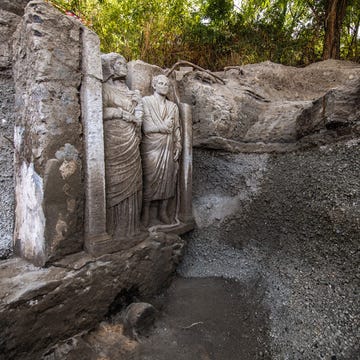- The oldest known part of the Great Wall of China was recently excavated, dating 300 years earlier than the previous record-holding section.
- This new find is part of the larger oldest part of the Great Wall—known as the Great Wall of Qi, it’s named for the Qi state that rose to power before China became a unified nation.
- Older, narrower parts of this ancient fortification are made of packed earth and stone, while the newer, wider parts were made of yellow earth strengthened by metal rammers.
Winding 21,196 kilometers (12,171 miles) from the east to the midwest of northern China, the Great Wall of China has remained standing for thousands of years, through the bloodshed and devastation of war after war. Now, a newly excavated part of the fortification meant to fend off the Huns (and later Mongols) pushes the beginnings of the construction of the Great Wall 300 years earlier than previously believed.
An excavation led by archaeologist Zhang Su of the Shandong Provincial Institute of Cultural Relics and Archaeology has unearthed the most ancient section of the Great Wall of Qi, which is 641 km (almost 400 mi) long and already the oldest known part of the wall. It took Zhang and his team from May to December of 2024 to carry out an excavation that spanned about 11,840 square feet. This section of the Qi Wall has been previously surveyed and investigated, but never actually excavated before.
The Great Wall of China, a UNESCO World Heritage site, was constructed using different methods during different time periods, and this excavation showed the evidence. Techniques such as carbon-14 dating and optically stimulated luminescence (which reveals when grains of soil were deposited and blocked from exposure to light or heat) showed that the earliest parts of the Qi Wall were built as far back as the Spring and Autumn period of the Zhou Dynasty (1046 B.C. - 256 B.C.) and continued to rise during the overlapping Warring States Period (475 B.C. - 221B.C.).
The land that is now China was not always united as one state. There used to be separate states, and during the earliest days of Qi wall construction, the Zhou Dynasty ruled over them. This was an era when art and literature flourished, and also the time of renowned philosopher Confucius (the Spring and Autumn Period is named after his work known as The Spring and Autumn Annals). Early parts of the wall erected at the time were about 33 feet wide.
Around 480 B.C., the Zhou Dynasty crumbled as tensions rose between the states. This led to the Warring States Period—three centuries of continuous clashes as each state vied to conquer the land. The later, better-preserved parts of the Qi wall were as wide as 98 feet, but they could not preserve the Qi state. Ultimately, the Qin state dominated China.
It is thought that the concept of a larger Great Wall can be traced to the defensive border walls erected by each state to keep out potential invaders. These early walls were made mostly of packed stone and earth, much like this older section of the Great Wall. The most durable part of the newly discovered segment of wall—built from yellow earth strengthened with metal rammers—aligns with the height of the Qi state’s power.
Also found at the archaeological site were the remains of semi-subterranean homes that Zhang’s team thinks made up a settlement that was built before the wall and meant to defend the Yellow River (on the banks of which the capital of the Zhou Dynasty once stood). Pingyin City—an ancient settlement near the Qi Wall and supposedly a Qi State stronghold that used to only exist in historical texts—was also discovered during the excavation.
"The layout, location, and associated infrastructure of the Great Wall of Qi reflect the Qi State's advanced military planning and strategic response to external threats,” Zhang told the Chinese newspaper Global Times. “Its close connection to Pingyin indicates that the wall served not only as a defense mechanism but also played a strategic role in controlling key transportation routes.”
Over time, the Great Wall of China would not just be used for military defense, but also to protect the beginnings of the Silk Road—a trade route with branches that spread from China through the Middle East and all the way to ancient Rome. The Great Wall took two millennia to build, and continues to survive as a reminder of a great empire that refused to fall.

Elizabeth Rayne is a creature who writes. Her work has appeared in Ars Technica, SYFY WIRE, Space.com, Live Science, Den of Geek, Forbidden Futures and Collective Tales. She lurks right outside New York City with her parrot, Lestat. When not writing, she can be found drawing, playing the piano or shapeshifting.













